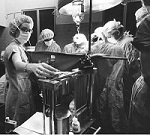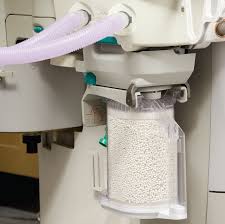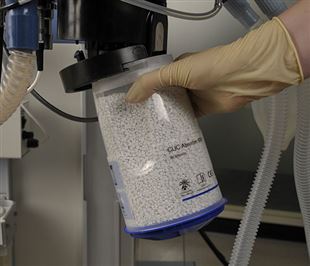
The Anesthesia Gas Machine
Michael P. Dosch CRNA PhD
University of Detroit Mercy - Nurse Anesthesia
This site is https://healthprofessions.udmercy.edu/academics/na/agm/index.htm.

The Anesthesia Gas Machine
Michael P. Dosch CRNA PhD
University of Detroit Mercy - Nurse Anesthesia
This site is https://healthprofessions.udmercy.edu/academics/na/agm/index.htm.
Revised May 2025

Function- makes rebreathing possible, thus conserving gases and volatile agents, decreasing OR pollution, and avoiding the hazards of carbon dioxide rebreathing. Soda lime- Activator is NaOH (or KOH). Silica and kieselguhr added as hardeners. Indicators for soda lime (such as ethyl violet) are colorless when fresh, and purple when exhausted, because of pH changes in the granules.
Problems:
The strong bases (NaOH, KOH which function as activators) have been convincingly implicated in the carbon monoxide problem with the methyl-ethyl ethers (des-, sevo, isoflurane), and the generation of Compound A by sevoflurane. Two definitive approaches to dealing with these problems have surfaced:
Lithium hydroxide lime (LitholymeTM, Allied Healthcare Products, Inc.) is an effective carbon dioxide absorbent, and is free of the strong bases (NaOH, KOH). Litholyme contains: LiCl as the catalyst; ethyl violet as the indicator; and does not contain KOH or NaOH. The CO2 absorbing capacity is similar to Sodasorb and more than Amsorb (see footnote 3). Litholyme does not produce Compound A or carbon monoxide from breakdown of any anesthetic agent under any circumstances even when it is desiccated (see footnote 4). Data supplied by the manufacturer shows that Litholyme:
Spiralith has lithium hydroxide (rather than calcium hydroxide) as its main constituent. Spiralith is a unique absorbent which is efficient, and does not degrade volatile agents. It does not desiccate since its water content is chemically bound. Spiralith is a powder enclosed in a polymer sheet, making the absorbent recyclable, and also limiting the danger to eyes and skin posed by dust in traditional absorbents. Since it lacks a color indicator, it may only be used with capnography monitoring.
Both Litholyme and Spiralith were found to be quite efficient in Aisys canisters (see footnote 5). Lithium hydroxide is a mature technology with a long history of use in space and submarine environments (though somewhat new in anesthesia applications).
Eliminating the activators entirely produces an absorbent which has similar physical characteristics (but slightly less carbon dioxide absorption efficiency), as compared to soda lime: Amsorb (Armstrong Medical Ltd., Coleraine Northern Ireland) (see footnote 6).
 Drägersorb 800 granules in CLIC absorber on Apollo. Click on the thumbnail, or on the underlined text, to see the larger version.
Drägersorb 800 granules in CLIC absorber on Apollo. Click on the thumbnail, or on the underlined text, to see the larger version.
New "house brand" absorbents have been created to help deal with the problems of modern volatile anesthetic (desflurane, sevoflurane) breakdown. "House brand" absorbents made by GE and Dräger have less activator, especially less KOH. Dräger makes an absorbent with decreased amounts of NaOH, and no KOH (Drägersorb Free) which will not generate Compound A or carbon monoxide under any circumstances (low flows, or desiccated granules (see footnote 7). GE makes Medisorb, which also has decreased amounts of strong bases.
For all:
| Component | Soda lime | Medisorb | Dragersorb Free | Amsorb Plus | Litholyme | Spiralith |
| Ca(OH)2 % | 94 | 70-80 | 74-82 | >80 | >75 | - |
| NaOH % (activator) | 2-4 | 1-2 | 0.5-2 | - | - | - |
| KOH % (activator) | 1-3 | 0.003 | 0 | - | - | - |
| LiOH % | - | - | - | - | - | 95 |
| Li2CO3 % | - | - | - | - | - | 3 |
| Lithium chloride % (catalyst) | - | - | - | - | < 3 | - |
| Water Content % | 14-19 | 16-20 | 14-18** | 13-18** | 12-19 | Unknown* |
| Size (mesh) | 4-8 | 4-8 | 4-8 | 4-8 | 4-8 | -* |
| Indicator | Yes | Yes | Yes | Yes | Yes | No |
* The water in Spiralith is chemically bound, so it does not desiccate. It does not have a granular size, since absorbent powder is encased in a polymer matrix, and it does not have an indicator.
** Draegersorb Free and Amsorb Plus contain CaCl2 as a humectant (helps retain moisture).
Numbers are approximations which may not sum to 100%.
Data sources for this table may be found in (see footnote 9).
#1 is called the first neutralization reaction. In #3 the second neutralization reaction and the regeneration of activator take place. CaCO3 is an insoluble precipitate.
If present, KOH participates in the reactions in the same manner as NaOH.
While it is possible to change canisters mid-case, it is safer to wait until the end of the case to do so. There are many case reports of inability to ventilate due to leaks after canisters could not be fit back together (see footnote 10).
 Canister Change in Aisys. Click on the thumbnail, or on the underlined text, to see the larger version.
Canister Change in Aisys. Click on the thumbnail, or on the underlined text, to see the larger version.
To change the absorbent granule canister on Aisys, press the latch release (arrow at left). The canister will pivot, and may then be slid off its rails (right). A new canister is then slid on, and pivoted upwards to latch.
 CLIC canister Change on Apollo. Click on the thumbnail, or on the underlined text, to see the larger version.
CLIC canister Change on Apollo. Click on the thumbnail, or on the underlined text, to see the larger version.
The CLIC canister (Apollo, Perseus) is changed in a similar way.
 |
Steps for changing Aestiva canisters. Click on the thumbnail, or on the underlined text, to see the larger version (23 KB). |
To change canisters in an older dual-canister setup (e.g. Aestiva):
Inspiratory and expiratory unidirectional valves which are functioning properly direct all exhaled gases through the absorbent granules. Provided these granules are intact (non-exhausted), and not channeling or otherwise inactivated, there can be no inspired carbon dioxide (i.e. FICO2 should be zero). Capnography (and properly set alarms) allow us to change canisters when inspired carbon dioxide exceeds a known threshold (2-3 cm H2O). Using FICO2 as the trigger for absorbent granule change is a more efficient use of granules than relying on color change (see footnote 11).
Signs of elevated inspired CO2